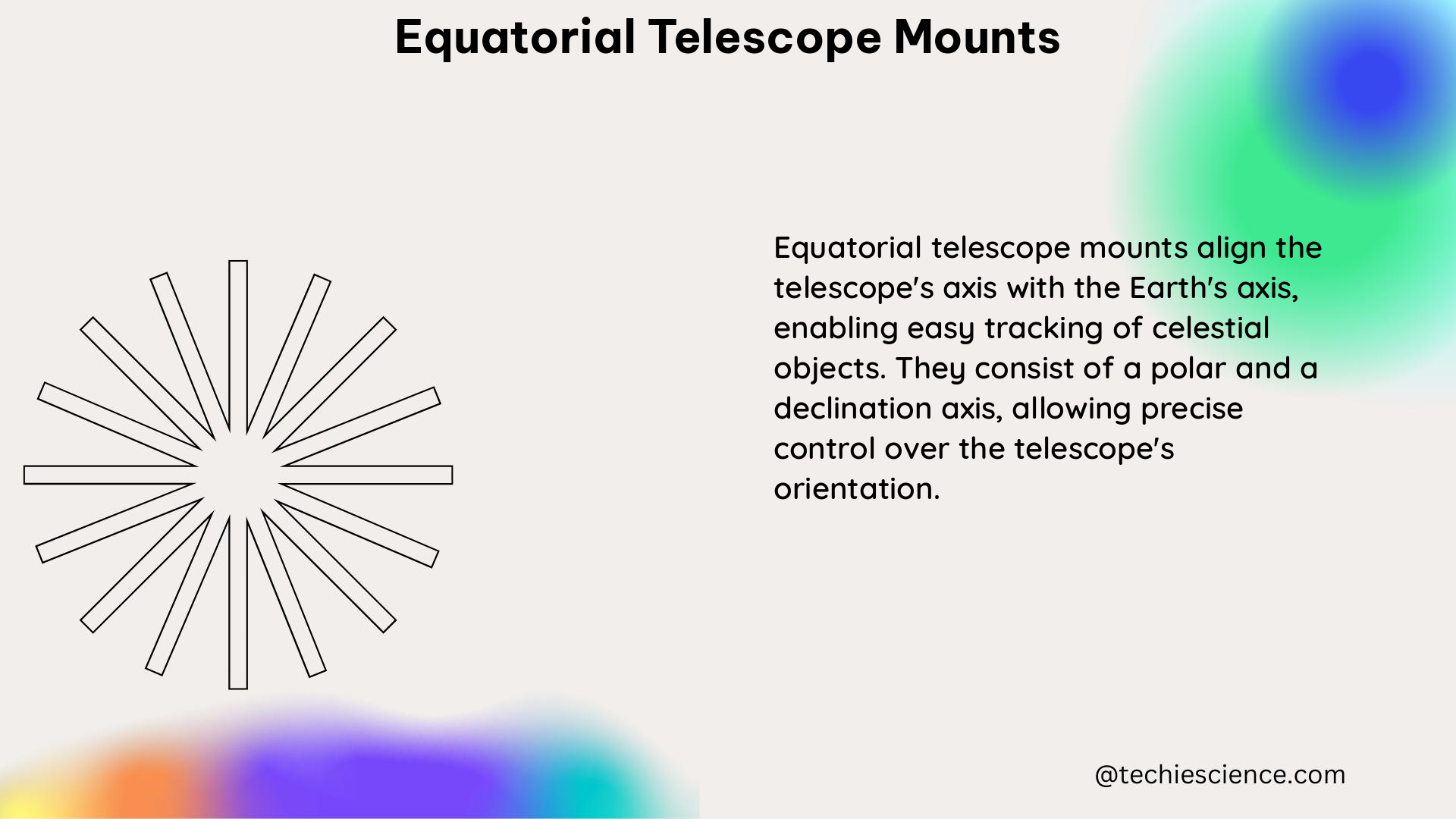Equatorial telescope mounts are specialized mounts designed for astronomical observations that enable the tracking of celestial objects as they move across the sky due to Earth’s rotation. These mounts have two axes of rotation, one of which is aligned parallel to the Earth’s axis of rotation, making it easier to track objects with a single motor. The polar alignment of the mount is crucial, and it can be achieved by adjusting the polar axis to point towards true north and inclining it to the horizontal at an angle equal to the observer’s latitude.
Understanding Equatorial Mount Alignment
Theorem of Equatorial Mount Alignment
The theorem of equatorial mount alignment states that for accurate tracking of celestial objects, the Right Ascension (RA) axis of the mount must be aligned with the Earth’s axis of rotation, and the polar axis must be inclined to the horizontal at an angle equal to the observer’s latitude.
Physics Formula for Polar Axis Inclination
The formula for calculating the angle of inclination of the polar axis is:
angle of inclination = observer's latitude
Physics Example of Polar Axis Alignment
Suppose an observer in Norwich, UK (latitude 52.6 degrees) wants to align their equatorial mount. They would need to incline the polar axis to 52.6 degrees to match their latitude.
Physics Numerical Problem for Polar Axis Alignment
If an observer in Sydney, Australia (latitude 33.9 degrees) wants to align their equatorial mount, what angle of inclination should they set for the polar axis?
Answer: The observer should set the polar axis to an angle of 33.9 degrees.
Quantifying Equatorial Mount Performance

The performance of equatorial mounts can be quantified using various metrics, including Root Mean Square (RMS) error and Full Width at Half Maximum (FWHM).
Root Mean Square (RMS) Error
RMS error is a metric that measures the deviation of the mount’s tracking from the ideal path. A lower RMS error indicates better tracking performance. For instance:
- An MX+ mount can achieve an RMS error of 0.4 arcseconds or less.
- An EQ6 mount can achieve an RMS error of 0.2 arcseconds or less.
However, comparing RMS error between different users can be challenging due to variations in seeing conditions, guiding systems, and mount loading.
Full Width at Half Maximum (FWHM)
FWHM measures the diameter of a star’s image at half its maximum intensity. Comparing the FWHM of short and long exposures can help determine the mount’s performance in different seeing conditions. Ideally, the FWHM should remain constant as the exposure time increases. The accuracy of FWHM measurements depends on the software used for measuring and the comparison of the same stars in both exposures.
Equatorial Mount Balancing and Optimization
Proper balancing and optimization of an equatorial mount are crucial for achieving the best tracking performance. This includes:
- Balancing the telescope and accessories along the RA and DEC axes to minimize the load on the motors.
- Adjusting the counterweights to ensure the mount is properly balanced.
- Ensuring the mount is level and the polar axis is accurately aligned.
- Calibrating the mount’s tracking and periodic error correction (PEC) to minimize tracking errors.
- Utilizing autoguiding systems or other advanced techniques to further improve tracking accuracy.
Conclusion
Equatorial telescope mounts are essential for accurate astronomical observations and astrophotography. By understanding the principles of equatorial mount alignment, quantifying their performance, and optimizing their setup, you can achieve the best possible tracking accuracy and image quality for your celestial observations.
References
- How to perfectly align your telescope’s equatorial mount – https://www.skyatnightmagazine.com/advice/align-a-telescope-mount
- Equatorial mounts complete guide – BBC Sky at Night Magazine – https://www.skyatnightmagazine.com/advice/equatorial-mounts-an-astronomers-guide
- How can we quantify mount tracking performance? – Cloudy Nights – https://www.cloudynights.com/topic/643860-how-can-we-quantify-mount-tracking-performance/
- How to Balance an Equatorial Mount – Hacks for Best Performance – https://www.youtube.com/watch?v=8wyZoGkFOxY

The lambdageeks.com Core SME Team is a group of experienced subject matter experts from diverse scientific and technical fields including Physics, Chemistry, Technology,Electronics & Electrical Engineering, Automotive, Mechanical Engineering. Our team collaborates to create high-quality, well-researched articles on a wide range of science and technology topics for the lambdageeks.com website.
All Our Senior SME are having more than 7 Years of experience in the respective fields . They are either Working Industry Professionals or assocaited With different Universities. Refer Our Authors Page to get to know About our Core SMEs.